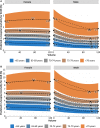Effect Modification of Sex and Age for the Hospital Volume-Outcome Relationship in Abdominal Aortic Aneurysm Treatment: Secondary Data Analysis of the Nationwide German Diagnosis Related Groups Statistics From 2005 to 2014
- PMID: 32172655
- PMCID: PMC7335519
- DOI: 10.1161/JAHA.119.014534
Effect Modification of Sex and Age for the Hospital Volume-Outcome Relationship in Abdominal Aortic Aneurysm Treatment: Secondary Data Analysis of the Nationwide German Diagnosis Related Groups Statistics From 2005 to 2014
Abstract
Background Trials and registries associated female sex and high age with unfavorable outcomes in abdominal aortic aneurysm treatment. Many studies showed an inverse correlation between annual hospital volume and in-hospital mortality. The volume-outcome relationship has not been investigated separately for women and men or across the age range. The aim was to analyze whether sex and age are effect modifiers or confounders of the volume-outcome association. Methods and Results In a nationwide setting, all in-hospital cases from 2005 to 2014 with a diagnosis of intact abdominal aortic aneurysm and procedure codes for endovascular or open aortic repair were included. Primary outcome was in-hospital mortality. Using a multilevel multivariable regression model, hospital volume was modeled as a continuous variable. Separate analyses were performed for women and men and for predefined age groups. A total of 94 966 cases were included (12% women; median age, 72 years). Mortality was 4.9% in women and 3.0% in men (3.2% overall). Mortality increased with age. Although there was no significant volume-outcome association in women (P=0.57), there was in men (P=0.02). The strongest volume-outcome association was found in younger men. The younger female subpopulation was found to show a trend for an inverse volume-outcome relationship, whereas an opposite association was found for the women aged >79 years. Conclusions Women have a higher mortality risk after elective abdominal aortic aneurysm treatment. Sex and age are modifiers of the volume-outcome relationship. Unlike in male patients, in women there is no consistent effect of hospital volume on outcome.
Keywords: endovascular aortic repair; hospital performance; hospital volume; in‐hospital mortality; secondary data analysis; sex differences; sex specific.
Figures






Similar articles
-
Editor's Choice - High Annual Hospital Volume is Associated with Decreased in Hospital Mortality and Complication Rates Following Treatment of Abdominal Aortic Aneurysms: Secondary Data Analysis of the Nationwide German DRG Statistics from 2005 to 2013.Eur J Vasc Endovasc Surg. 2018 Feb;55(2):185-194. doi: 10.1016/j.ejvs.2017.11.016. Epub 2017 Dec 27. Eur J Vasc Endovasc Surg. 2018. PMID: 29289619
-
The Relationship Between Operative Volume and Peri-operative Mortality After Non-elective Aortic Aneurysm Repair in Australia.Eur J Vasc Endovasc Surg. 2020 Oct;60(4):519-530. doi: 10.1016/j.ejvs.2020.04.029. Epub 2020 Jul 2. Eur J Vasc Endovasc Surg. 2020. PMID: 32624387
-
The effect of hospital factors on mortality rates after abdominal aortic aneurysm repair.J Vasc Surg. 2014 Dec;60(6):1446-51. doi: 10.1016/j.jvs.2014.08.111. Epub 2014 Oct 14. J Vasc Surg. 2014. PMID: 25441675
-
Is volume important in aneurysm treatment outcome?J Cardiovasc Surg (Torino). 2017 Apr;58(2):187-193. doi: 10.23736/S0021-9509.16.09821-9. Epub 2016 Dec 1. J Cardiovasc Surg (Torino). 2017. PMID: 27905691 Review.
-
Systematic review and meta-analysis of sex differences in outcomes after endovascular aneurysm repair for infrarenal abdominal aortic aneurysm.J Vasc Surg. 2020 Jan;71(1):283-296.e4. doi: 10.1016/j.jvs.2019.06.105. Epub 2019 Aug 26. J Vasc Surg. 2020. PMID: 31466739
Cited by
-
Mortality following elective abdominal aortic aneurysm repair in women.Br J Surg. 2022 Mar 15;109(4):340-345. doi: 10.1093/bjs/znab465. Br J Surg. 2022. PMID: 35237792 Free PMC article.
-
Translating mouse models of abdominal aortic aneurysm to the translational needs of vascular surgery.JVS Vasc Sci. 2021 Mar 3;2:219-234. doi: 10.1016/j.jvssci.2021.01.002. eCollection 2021. JVS Vasc Sci. 2021. PMID: 34778850 Free PMC article. Review.
-
The Effects of Minimum Caseload Requirements on Management and Outcome in Abdominal Aortic Aneurysm Repair.Dtsch Arztebl Int. 2020 Oct 20;117(48):820-827. doi: 10.3238/arztebl.2020.0820. Dtsch Arztebl Int. 2020. PMID: 33568259 Free PMC article.
-
Impact of patient sex on selection for abdominal aortic aneurysm repair: a discrete choice experiment.BMJ Open. 2025 Feb 26;15(2):e091661. doi: 10.1136/bmjopen-2024-091661. BMJ Open. 2025. PMID: 40010836 Free PMC article.
-
A Bibliometric Analysis of Diagnosis Related Groups from 2013 to 2022.Risk Manag Healthc Policy. 2023 Jul 2;16:1215-1228. doi: 10.2147/RMHP.S417672. eCollection 2023. Risk Manag Healthc Policy. 2023. PMID: 37425618 Free PMC article. Review.
References
-
- Stoberock K, Kolbel T, Atlihan G, Debus ES, Tsilimparis N, Larena‐Avellaneda A, Behrendt CA, Wipper S. Gender differences in abdominal aortic aneurysm therapy—a systematic review. Vasa. 2018;47:267–271. - PubMed
-
- Hafez H. National Vascular Database analysis: the relationship between AAA repair volume and outcome. Br J Surg. 2012;99:4. - PubMed
-
- Holt PJ, Karthikesalingam A, Hofman D, Poloniecki JD, Hinchliffe RJ, Loftus IM, Thompson MM. Provider volume and long‐term outcome after elective abdominal aortic aneurysm repair. Br J Surg. 2012;99:666–672. - PubMed
-
- Holt PJ, Poloniecki JD, Khalid U, Hinchliffe RJ, Loftus IM, Thompson MM. Effect of endovascular aneurysm repair on the volume‐outcome relationship in aneurysm repair. Circ Cardiovasc Qual Outcomes. 2009;2:624–632. - PubMed
-
- Holt PJ, Poloniecki JD, Loftus IM, Michaels JA, Thompson MM. Epidemiological study of the relationship between volume and outcome after abdominal aortic aneurysm surgery in the UK from 2000 to 2005. Br J Surg. 2007;94:441–448. - PubMed
Publication types
MeSH terms
LinkOut - more resources
Full Text Sources

